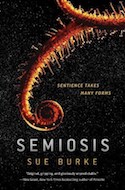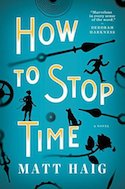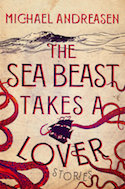Future Alternative Past: in need of schooling
Every month, Nisi Shawl presents us with news and updates from her perch overlooking the world of science-fiction, fantasy, and horror. You can also look through the archives of the column.
The best way to learn something
My friend Kristin King asked a while back for book recommendations on Facebook, as you do. But she was looking for something very specific: science fiction dealing with schools. I only came up with two titles for her. First, John Varley’s lovely, haunting, and somewhat contrarian Beatnik Bayou, then my own rather hard-to-locate "Walk Like a Man".
Originally published in George R.R. Martin’s New Voices III anthology, and now available in the 2004 collection The John Varley Reader, Beatnik Bayou tells how a far-future child learns from and eventually outgrows her teacher. The teacher’s development has been artificially arrested at a point beneficial to the student. That part of the job description carries with it a whiff of tragedy — especially as we realize as the story ends that the teacher actually likes the career’s built-in limitations.
“Walk Like a Man” appeared in 2015 in the first and only issue of the wondrous literary journal Bahamut. It takes place in a future school whose primary raison d’être is socialization rather than the imparting of knowledge. Which is why my AI protagonist attends.
With help you can find many more examples, even without expanding the search into other speculative fiction subgenres. Isaac Asimov’s “The Fun They Had,” set in 2157, similarly supposes that learning per se can be imparted without schools; children discover a book describing groups of students attending classes together and dream longingly of sharing the experience.
Lots of school-related SF tales use this Matrix-like template of downloadable knowledge (as when Keanu Reeves declares “I know kung fu!”). Not all of them, of course; Zenna Henderson’s Holding Wonder collection includes short stories based on different plots, such as “The Indelible Kind,” in which a teacher and a student rescue a Russian cosmonaut. The Binti novellas by Nnedi Okorafor take place at an exclusive off-planet university.
Horror typically replicates the awfulness of the compulsory school experience. Stephen King’s Carrie, for instance, details the vindictive bullying and ostracism that sends his telekinetic heroine into a killing frenzy. But The Girl with All the Gifts by M.R. Carey changes that up; it starts off in a school for zombies.
School-centered fantasies such as J.K. Rowling’s Harry Potter series or Okorafor’s Akata books postulate schools for teaching the practice of magic.
My favorite of this genus is A Wizard of Earthsea, by the late great Ursula K. Le Guin, in which fledgling magician Sparrowhawk matriculates to such a school on the Isle of Roke. I’m also partial to her short story “The Day Before the Revolution.” Though elderly protagonist Laia Odo doesn’t teach anarchist theory formally, classes of all ages take field trips to visit her. She enjoys the company but privately abhors her role as surrogate mother.
Of course “The Day Before the Revolution” would be classified more as SF than F, bringing us back to where we started.
If science can be defined as a way of knowing, then some of these sorts of school-related stories can be considered meta-science fiction. At the very least the overall category merits an additional “s”. A list of readings in SSFFH by Seanan McGuire, Greg Bear, Naomi Kritzer, Caroline Stervermer, and its other authors would make a lovely syllabus.
Recent books recently read

Is Sue Burke’s first novel, Semiosis (Tor) hard or soft SF? It takes place on an extra-solar planet, chronicling three pioneering generations of an Earth-based colonizing effort. But it’s by a woman, and it deals primarily in the “squishy” biological sciences. So, hmmmm.
Even before they land, the book’s colonists are in a jam: their 158-year voyage has brought them to the wrong sun! Failures in on-ship hibernation systems, and crashes destroying a third of their equipment further handicap the enterprise. They forge ahead — what else is there to do? As the colonists adapt to packs of predatory flightless birds and plant-based intelligences, Burke’s title (which my online dictionary defines as “the process of signification in language or literature”) gains meaning and resonance. The author’s clear, straightforward narrative style underscores the intrinsic ambiguity of interspecies communication, and the dangers and potentials of that ambiguity.

How to Stop Time (Viking) by Matt Haig reads like a paranormal romance — think a masculine version of the novels of Deborah Harkness or Diana Gabaldon. Yet it can easily be classified as science fiction. There’s nothing inherently impossible in a genetic mutation that allows its bearers to live 15 times longer than the rest of us. No supernatural abilities are necessary to ensure the successful machinations of Hendrich, who nicknames his fellows in longevity “albatrosses” and uses them to run his murderous errands. The love that binds protagonist Tom Hazard to his 17th century wife Rose, and then again to 21st century French teacher Camille, is completely understandable and human. I was sometimes impatient with Tom’s interiority and fecklessness, but quite pleased at the presence of disabled and nonwhite characters sans unnecessary (in my view) rationales for their existence. A fine and fascinatingly down-to-earth look at longevity.

The Sea Beast Takes a Lover (Dutton) collects short stories by UC Irvine MFA graduate Michael Andreasen. His debut is marketed as both “contemporary fantasy” and “literary fiction.” It could be categorized as what my old writing instructor Howard Waldrop calls “a New Yorker-cup-of-coffee-style story” — if the coffee cup were being held out to you by a tentacle. Yes, you take about the same amount of time to read one of these stories as you would to drink a latte. And yes, per Howard’s annoyed assessment, there are times when protagonists’ situations seem static and their character arcs flat — or as he puts it, “The deer is dead at the beginning of the story and at the end of the story the deer is still dead.” But as you sip you’ll ruminate on greasy-skinned Rocketeers and bodhisattvan baby brothers, on Kerouac-reading mermaids and disappointed adulterers comparing their mistresses’ breasts to raw eggs. Which is not without its rewards.
Couple of upcoming cons
The organizers of the Association of Writers and Writing Programs Conference probably prefer for it not to get lumped in with genre conventions. Academia is the watchword, with works in fantasy, horror, and science fiction considered noteworthy simply because they’re outside the literary mainstream. Panel titles (and it’s pretty much all panels) include “The Mentor/Mentee Relationship for Creative Writers,” “From Thesis to Published Book,” and “Building a Social Justice Curriculum.” I’m there.
Meanwhile, the Outer Dark Symposium on the Greater Weird is also hovering at and around the traditional convention plateau without quite landing there, having approached it from a totally different direction. Abolishing economic boundaries between professional writers and fandom, the Outer Dark asks all attendees to pay their way. The focus on genre edginess and the presence of authors of color such as Craig Laurance Gidney and Silvia Moreno-Garcia are elements carried over from the compellingly intersectional podcast with which it originates.